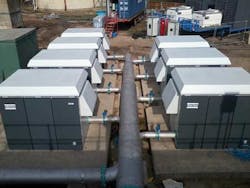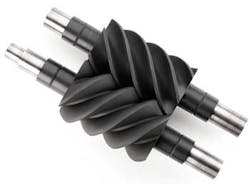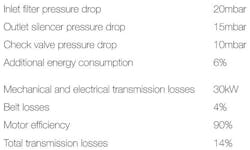Wastewater Aeration: Low-pressure Screw Blowers Vs. Traditional Lobe Technology
Air supply is a critical component for aeration processes within wastewater treatment. Although traditional lobe blowers are common, advances in screw blowers are showing how energy savings can be made for utilities. Rob Boughton looks at the difference between the two and an application in Denmark.
Acontinuous reliable regulated supply of quality air is a critical requirement for the aeration diffuser systems within municipal and industrial wastewater treatment plants. This is in order to guarantee continuity of process operations and clean, uncontaminated discharge into the environment.
Yet despite the vital role that air supply represents in the treatment process, many facilities use lobe blower technology that was introduced in the late 19th century.
Since then, a range of screw technology ZS blowers have been developed with the aim of providing a reliable low pressure, oil-free positive displacement blower system.
In making a true wire-to-air performance comparison between the old and new technologies it is necessary take into account not just comparable shaft power ratings but all of the potential power losses that can occur in a blower package − from motor and electrical system to transmission, filters, and other design features that contribute to pressure drops which are costly in energy terms.
For instance, a 50 mbar/0.7 psi pressure drop may appear to be small but when a blower is only providing a 500 mbar/7 psi discharge pressure this adds up to 10% of the power consumption.
Lobe blower data is commonly offered by giving the air intake flow volume and the shaft power of the bare element whereas low pressure screw compressors are quoted by listing the FAD (free air delivered) at the unit outlet and the power consumption at the terminals of the power supply.
The air flow path before and after the blower element includes air-inlet filter, air-inlet silencer, air-outlet silencer and the check valve. The pressure drop over these components has to be added to the performance data of the lobe blower element. Such losses, as well as those incurred by electrical and mechanical transmission, are not always considered in the data of lobe blowers but they are always taken into account in the low-pressure screw compressor data.
Transmission losses, measured from the terminals of the power supply to the shaft power of the blower element, consist of the losses of the electric motor and the belt drive transmission losses from the motor shaft to the element. These figures vary generally as a function of the blower size and the operating point but typical values, for a 110 kW small lobe type blower with an output of 1,000 m³/h operated at 0.7 bar(e) compared to a 75kW screw blower, are as follows:
Screw blowers also have some degree of air flow path and transmission losses, but they are already taken into account when listing the system data, measured at the power supplies input and the compressed air outlet.
To deliver a flow of 1600 m³/hr (942 cfm) at a pressure of 0.8 bar(e) (11.6 psig), a tri-lobe blower would consume 61 kW (82 hp) on average whereas a comparable screw blower demands only 43kW (58hp) for the same volume. In fact, the SER (Specific Energy Requirement) is on average 28% lower and at a 600 millibar 50% load this can increase to as much as 34%.
It is clear that wastewater treatment plant operations and many other industry low- pressure blower applications can benefit substantially from improved reliable performance and significant energsavings through modernising their wastewater aeration equipment.
Author's note: Rob Boughton is from Atlas Copco Compressors. For more information, please email: [email protected].
Screw blower installation in Skanderborg, DenmarkWith a savings goal set at 25% for the Danish wastewater industry, optimizing all parts of the operation, especially aeration, is of the highest importance. Up to 70% of the energy consumed by a Wastewater Treatment Plant (WWTP) consists of low pressure aeration of the wastewater. This is why savings in this part of the process is of paramount importance. The wastewater treatment plant in Skanderborg, Denmark, recently replaced one of its 75 kW lobe blowers with a new 55 kW Atlas Copco ZS screw blower and were able to reduce their energy consumption by 31%. “Skanderborg WWTP had problems with their aeration using lobe blowers so we suggested that they should try the Atlas Copco ZS blowers", says Flemming Broksø, from Atlas Copco Compressor Technique Scandinavia. A new 55 kW variable speed drive blower was delivered by Atlas Copco, operating at 0.7 bar(e), to Skanderborg WWTP, replacing a 75 kW lobe blower in one of the aeration process lines. During August every year in Skanderborg the traditional Summer Festival takes place. This is the time of the year when the work load is at its highest for Skanderborg WWTP and where the blowers operate on maximum capacity. During the festival, a test was carried out by Skanderborg WWTP comparing the energy consumption of the two identical aeration process lines. Both lines are equipped with two blowers each – one variable speed drive and one fixed speed. The operations are set up so that the variable speed drive blowers function as the primary blowers and the fixed speed blowers come in when the demand for low pressure air increases. Line 1: 1 75 kW lobe blower, variable speed drive 1 75/62 kW (dual speed) lobe blower, fixed speed Line 2: 1 Atlas Copco ZS55VSD-700 screw blower, variable speed drive 1 75/62 kW (dual speed) lobe blower, fixed speed The result: Line 1: Total energy consumption: 19 989 kWh. Line 2: Total energy consumption: 14 492 kWh The figures show a total saving of energy for Line 2 – including the Atlas Copco ZS screw blower – at 31 %. |




